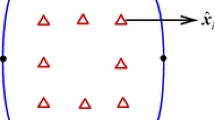Abstract
This study combines the boundary integral equation (BIE) method and improved moving least-squares (IMLS) approximation to present a direct meshless boundary integral equation method, the boundary element-free method (BEFM) for three-dimensional elasticity. Based on the improved moving least-squares approximation and the boundary integral equation for three-dimensional elasticity, the formulae of the boundary element-free method are given, and the numerical procedure is also shown. Unlike other meshless boundary integral equation methods, the BEFM is a direct numerical method in which the basic unknown quantity is the real solution of the nodal variables, and the boundary conditions can be applied directly and easily, thus giving it a greater computational precision. Three selected numerical examples are presented to demonstrate the method.
Similar content being viewed by others
References
Beer G, Watson JO (1989) Infinite boundary elements. Int J Numer Methods Eng 28:1233–1247
Beer G (1993) An efficient numerical method for modeling initiation and propagation of cracks along material interfaces. Int J Numer Methods Eng 36:3579–3595
Tabatabai-Stocker B, Beer G (1998) A boundary element method for modeling cracks along material interfaces in transient dynamics. Commun Numer Methods Eng 14:355–365
Belytschko T, Krongauz Y, Organ D, Fleming M, Krysl P (1996) Meshless method: An overview and recent developments. Comput Methods Applied Mech Eng 139:3–47
Lancaster P, Salkauskas K (1981) Surface generated by moving least squares methods. Math Comput 37:141–158
Liew KM, Huang YQ, Reddy JN (2003) Moving least squares differential quadrature method and its application to the analysis of shear deformable plates. Int J Numer Methods Eng 56:2331–2351
Liew KM, Zou GP, Rajendran S (2003) A spline strip kernel particle method and its application to two-dimensional elasticity problems. Int J Numer Methods Eng 57:599–616
Liu GR, Gu YT (2000) Coupling of element free Galerkin and hybrid boundary element methods using modified variational formulation. Comput Mech 26:166–173
Gu YT, Liu GR (2000) A boundary point interpolation method for stress analysis of solids. Comput Mech 28:47–54
Gu YT, Liu GR (2001) A coupled element free Galerkin/boundary element method for stress analysis of two-dimensional solids. Comput Methods Applied Mech Eng 190:4405–4419
Liu GR (2002) Mesh Free Methods: Moving Beyond the Finite Element Method. CRC press, Boca Raton, USA
Gu YT, Liu GR (2003) A radial basis boundary point interpolation method for stress analysis of solids. Struct Eng Mech 15(5):535–550
Gu YT, Liu GR (2003) Hybrid boundary point interpolation methods and their coupling with the element free Galerkin method. Eng Anal Boundary Elements 27(9):905–917
Chati MK, Mukherjee S, Mukherjee YX (1999) The boundary node method for three-imensional linear elasticity. Int J Numer Metho Eng 46:1163–1184
Chati MK, Mukherjee S (2000) The boundary node method for three-dimensional problems in potential theory. Int J Numer Methods Eng 47:1523–1547
Zhu T, Zhang JD, Atluri SN (1998) A local boundary integral equation (LBIE) method in computational mechanics, and a meshless discretization approach. Comput Mech 21: 223–235
Timoshenko SP, Goodier JN (1970) Theory of elasticity (Third edn), McGraw-Hill Inc.,
Author information
Authors and Affiliations
Additional information
Aknowledgement The work in this project was fully supported by a grant from the Research Grants Council (RGC) of the Hong Kong Special Administrative Region, China (Project No. CityU 1011/02E).
The work that is described in this paper was supported by Project No. CityU 1011/02E, which was awarded by the Research Grants Council of the Hong Kong Special Administrative Region, China. The authors are grateful for the financial support.
Rights and permissions
About this article
Cite this article
Kitipornchai, S., Liew, K. & Cheng, Y. A boundary element-free method (BEFM) for three-dimensional elasticity problems. Comput Mech 36, 13–20 (2005). https://doi.org/10.1007/s00466-004-0638-1
Received:
Accepted:
Published:
Issue Date:
DOI: https://doi.org/10.1007/s00466-004-0638-1




